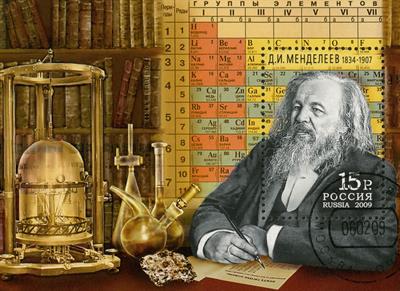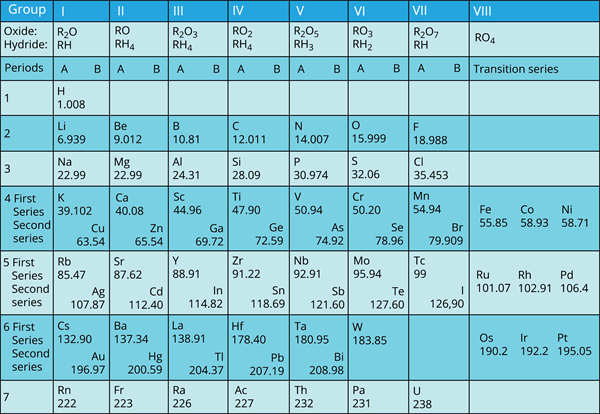
PUMPA - SMART LEARNING
எங்கள் ஆசிரியர்களுடன் 1-ஆன்-1 ஆலோசனை நேரத்தைப் பெறுங்கள். டாப்பர் ஆவதற்கு நாங்கள் பயிற்சி அளிப்போம்
Book Free DemoDmitri Mendeléev:
Dmitri Ivanovich Mendeléev, a Russian chemist and inventor, was born on February \(8\), \(1834\), in Tobolsk, Western Siberia. He was only able to attend a university after his early schooling because of his mother's efforts.

Dmitri lvanovich Mendeléev (1834 -1907)
The arrangement of elements proposed by Mendeleev is known as the periodic table. In chemistry, the periodic table proved to be the unifying concept. It was the motivation for the discovery of a few new elements.
Even after the dismissal of Newlands’ Law of Octaves, many scientists continued to look for a pattern that linked element properties to their atomic masses.
The main credit for classifying elements goes to Mendeléev. He was the most dominant contributor to the early development of a periodic table of elements wherein the elements were arranged based on their fundamental property, atomic mass, and the similarity of chemical properties.
When Mendeléev began his work, there were \(63\) known elements. He studied the relationship between an element's atomic mass and its physical and chemical properties. Mendeléev focused on the compounds formed by elements including oxygen and hydrogen when it came to chemical properties. He chose hydrogen and oxygen because they are highly reactive and can form compounds with almost any element. The formulae of an element's hydrides and oxides were treated as one of the element's basic properties for classification.
He took \(63\) cards and wrote down the properties of one element on each card. He sorted the elements with similar properties and pinned them to a wall. He noticed that most elements were assigned to a periodic table and were arranged in increasing atomic masses. He also discovered that elements with similar physical and chemical properties reoccur regularly.
In \(1869\), Mendeléev developed a periodic law on this basis, which stated that "the properties of elements are the periodic function of their atomic masses."
Mendeléev's periodic table has vertical columns known as "groups" and horizontal rows known as "periods."
Mendeléev’s periodic table:

Mendeléev's periodic table was first published in a German journal in \(1872\). The letter 'R' represents any elements in the oxides and hydrides formula at the top of the columns. Take note of how formulas are written. For example, the carbon hydride, \(CH_4\), is written as \(RH_4\), and the oxide \(CO_2\) is \(RO_2\).
Features of Mendeleev’s Periodic Table:
In Mendeleev's periodic table, elements are arranged in rows and columns. Let's take a closer look at the rows and columns, as well as the elements that make them up.
- The horizontal rows of the periodic table are referred to as series. These series are further sub-divided into periods, which are horizontal columns. The periodic table shows that there are seven periods.
- The properties of elements in a given period show a regular gradation from left to right (i.e. increase or decrease).
- The vertical columns are referred to as groups. You've probably noticed that there are nine of them, numbered from I to VIII and Zero (Roman numerals).
- Groups I-VII are further sub-divided into subgroups A and B. Groups Zero and VIII have no sub-groups.
- Chemically, all elements in a certain group are similar in nature. A regular progression is shown by physical properties and chemical reactivities.